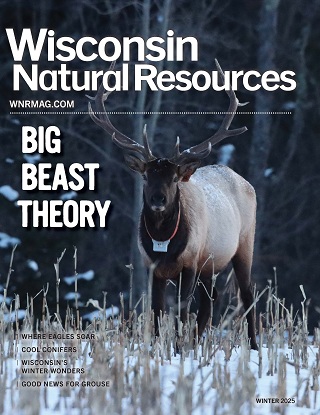A hopeful vision for native mussel management
VULNERABLE SPECIES WITH A TURBULENT PAST MAY BE POISED FOR BETTER DAYS AS CONSERVATION EFFORTS CONTINUE
Lisa Gaumnitz
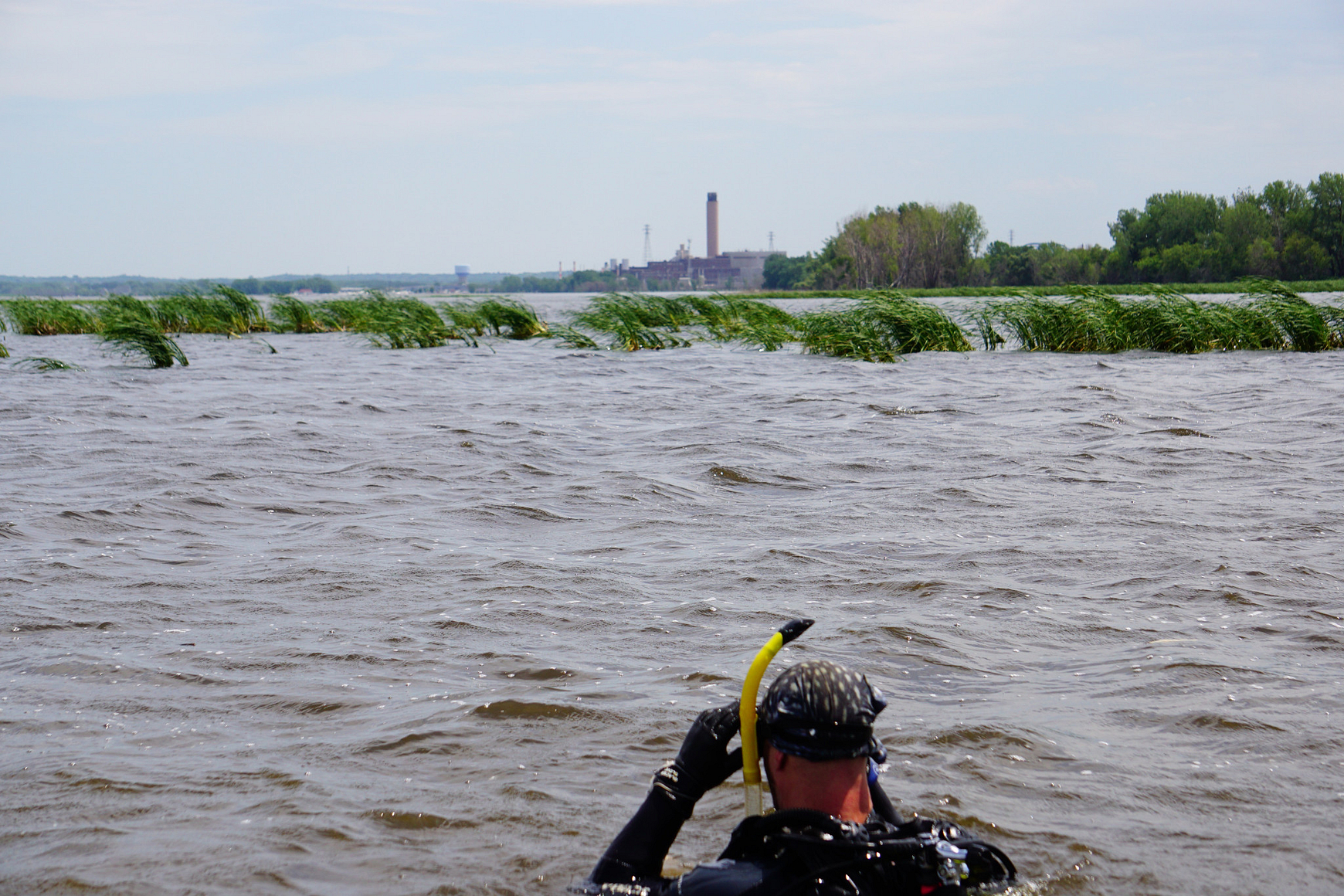 Improving water quality in Green Bay is allowing native mussels to stage a comeback and may support a restoration project.© JACK SILVERBERG
Improving water quality in Green Bay is allowing native mussels to stage a comeback and may support a restoration project.© JACK SILVERBERGOn a warm June day, cars roar along the Highway 41/43 bridge over Green Bay as DNR conservation biologist Jesse Weinzinger maneuvers his boat into place in the shallow pool where Duck Creek empties into the bay.
A retired power plant looms in the distance and a dredge drones on a few hundred yards away, digging up PCBs and other toxic chemicals dumped in the Lower Fox River decades ago by paper mills and other industries.
It's been half a century since mussel populations in this area flatlined, among the wildlife most vulnerable to pollution. Now, the massive years-long Fox River Cleanup Project and other significant efforts have improved the waters of Lower Green Bay and the Lower Fox River to the point that native mussels present a promising wildlife restoration opportunity.
Weinzinger is joined on the boat by Jake Winkler, a fellow DNR conservation biologist, and Sam Hoffman, a University of Wisconsin-Green Bay graduate student. The two are helping record data for the day.
Winkler drops the anchor and he and Weinzinger get ready for the first of four dives to look for water-filtering native mussels and their habitats.
"It will be interesting to see what we get here," Weinzinger says.
* * *
Weinzinger was on a path to be a wildlife biologist in a state where Aldo Leopold pioneered game management and deer hunting is king.
But the burly biologist chose mussels over mammals for his graduate study after talking to an advisor and hearing a presentation from Lisie Kitchel, a DNR conservation biologist with an encyclopedic knowledge and spellbinding tales of native mussel names, their unique biology and their history feeding Wisconsin button factories and Japanese pearl growers.
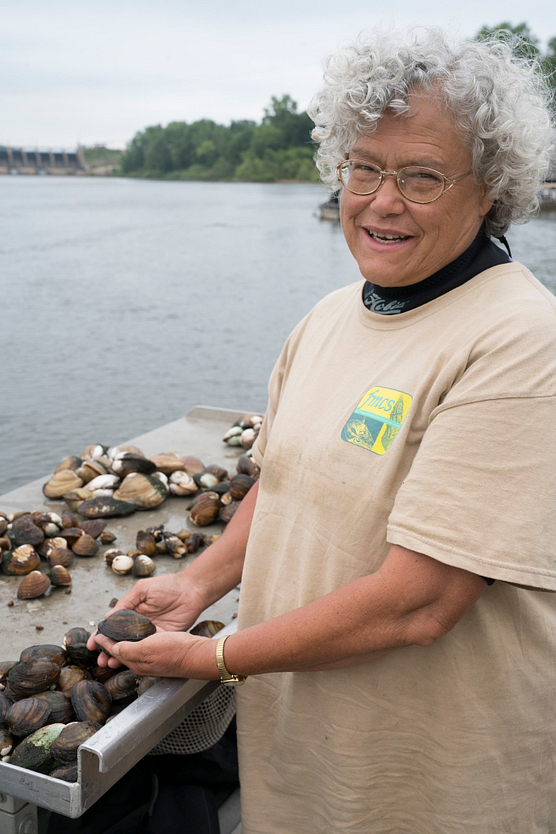 DNR Conservation Biologist Lisie Kitchel has been working with mussels since the 1970s. © MICHAEL L. KIENITZ
DNR Conservation Biologist Lisie Kitchel has been working with mussels since the 1970s. © MICHAEL L. KIENITZYes, mussels. Wartybacks, white heelsplitters, plain pocketbooks, pimplebacks and 46 other species of mollusks whose memorable monikers belie their rather humble exteriors and hidden talents.
"I was hooked," Weinzinger says. "I love the services they provide. Mussels are ecosystem engineers. They are the kidneys of freshwater systems.
"One mussel bed in the Upper Mississippi River filters over 21 million gallons a day. And that service is free."
For the last five years, Weinzinger, Kitchel and partners have helped engineer some exciting projects and prospects for mussels, one of the world's most endangered groups of animals. Seventy percent of species are at risk globally, and nearly half — or 24 of Wisconsin's 50 species — are endangered, threatened or of special concern, meaning their populations are low or declining.
The two DNR conservation biologists have completed the first statewide mussel survey in 40 years, been part of multi-state, multi-agency efforts to propagate and reintroduce endangered mussels to the Wisconsin and Chippewa rivers, and are laying the groundwork to reintroduce mussels to Green Bay and other tributaries and major rivers.
"Our mussels have managed to hang in there despite what we humans have done to their habitat and water quality," says Kitchel, who first began working with mussels on the Mississippi River in the late 1970s. "Now, water quality is coming back, we're removing dams and we're propagating mussels.
"We can now put them back in areas where we thought they were gone forever."
Life cycle of a native mussel
People use the terms "mussels" and "clams" interchangeably and that's generally acceptable, but technically, physiologically and taxonomically, there are differences between the two.
Native mussels require a fish host and can grow very large, some species reaching 10 inches across. Native clams don't need fish hosts and are very small, their size signaled by names such as pea clams and fingernail clams.
"If you come across something bigger than a quarter, you definitely have a native mussel," Kitchel says.
Mussels, particularly Wisconsin's rare species, are most often found in rivers. Running water brings them food and oxygen and takes away their waste. But some species do well in lakes, among them a common species called floaters, Kitchel says.
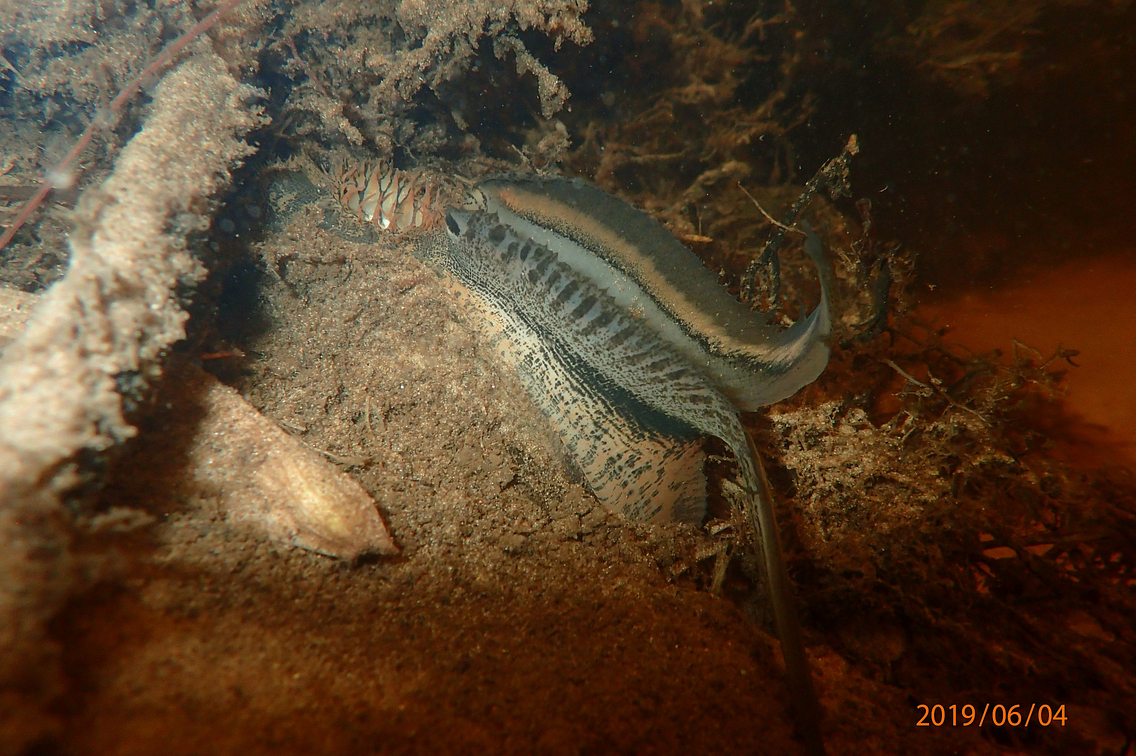 Because larval mussels need a fish host, adult females mimic fish prey to attract a fish so their young can attach to its gills. © B. SIETMA
Because larval mussels need a fish host, adult females mimic fish prey to attract a fish so their young can attach to its gills. © B. SIETMAMussels' unique life cycle begins when males release sperm that females draw in through their intake siphons. The fertilized eggs develop into larvae called glochidia, which the female expels when target fish are near.
"The sole purpose of glochidia is to get onto the gills of fish — the right fish," Kitchel says. "They need fish blood to develop their internal organs, and they cannot feed by themselves."
Female mussels use specialized lures and behavior to attract their meal ticket. Part of the plain pocketbook mussel, for example, looks like a minnow to draw in fish, while a package of glochidia can imitate worms that are prey for its potential host.
Juvenile mussels remain on the fish as harmless parasites for a few weeks or months and then fall to the riverbed or lakebed, where they begin a one- to eight-year maturation process if the water current and bed materials, or substrate, are hospitable.
Mussels can easily live 20 to 30 years, with the oldest documented mussel in Wisconsin checking in at more than 80 years. In addition to filtering water, mussels provide food for raccoons, muskrats, otters, herons and even fish when the mussels are young. After they've died, their shells provide safe places for fish and aquatic insects to lay their eggs.
* * *
The pool where Weinzinger's boat is anchored is undergoing work to restore wild rice beds. Nearby, the restoration of Cat Island has already lured some high-profile visitors, including endangered piping plovers. Mussel surveys in the pool in 2018 found juvenile mussels, signs of natural reproduction and a 24-year-old fatmucket mussel.
"Because Duck Creek is promising habitat for a reintroduction, we want to get to know it better," Weinzinger says.
He and Winkler zip up their wetsuits, strap on their oxygen tanks and put in their regulator mouthpieces. Sitting on opposite sides of the boat, they yell, "Going in!" one after another and fall backward into the water. Hoffman starts the timer for their first 15-minute search for mussels.
The two disappear from sight beneath the choppy waves.
From a humble shell, fabulous finery
Native Americans ate mussels before European settlement but it is now illegal to harvest mussels and inadvisable to eat them because of environmental contaminants like PCBs, mercury and other metals that have built up in their soft tissues.
Starting in the 1880s, mussels supported a booming button-making industry in Wisconsin.
"Not just on the Mississippi River, but all over," Kitchel says. "Mussels were collected from the 1880s to the 1920s until plastic came on the scene. Plastic was easier and cheaper."
Buttons were largely made from bone, antlers and nutshells until German immigrant and button maker George Boepple stepped on a heelsplitter mussel and cut himself. He picked up the shell to examine it, noticed the pearly inside and invented a machine to punch buttons out of the shells.
"The irony in his life is that many years later, he was fishing in a stream and again stepped on a heelsplitter. He got lockjaw and died," Kitchel says. "(Mussels) made him rich and they killed him."
After buttons came pearls. Mussels from the Upper Mississippi River became a mainstay of Japan's cultured pearl industry.
Shells collected here were cut up there and turned into the seed from which pearls were cultured. Overharvest of mussels on the Upper Mississippi River led to closing of the commercial mussel harvest in the 1980s, Kitchel says.
By then, mussel populations had declined precipitously in many places due to factors including water and sediment pollution, dams and overharvest.
In some major rivers, the arrival and proliferation of zebra mussels delivered a final death blow. These nonnative mussels attach to the shells of native mussels and encapsulate them, making it impossible for native mussels to open their shells to get food and oxygen.
* * *
At 12 minutes into the 15-minute dive, Weinzinger's gloved hand breaks the water's surface and thrusts a mussel aloft. He sinks back into the water and disappears again.
Three minutes later, a spotter bangs a hammer on the bottom of the boat, alerting the divers their time is up. Weinzinger returns to the boat.
"We got some mussels!" he yells, dumping the contents of his mesh bag at the back of the boat.
"Sweet!" Hoffman says. He grabs his clipboard and starts recording information.
Weinzinger gives a quick rundown of the collected species. There are three giant floaters, two fatmuckets, a mapleleaf and a white heelsplitter with a bonus: a freshwater sponge attached to the inside of the shell, a good sign since such sponges are intolerant of pollution.
Also encouraging, the mussels are a mix of ages, which Weinzinger assesses by counting the annuli, or rings laid down over the years on the shell, similar to the rings of a tree.
State survey shows mixed fortunes
Mussel surveys of specific waters have shown mussel populations increasing in some major rivers again, thanks to protections afforded by state and federal endangered species laws and improved water quality since the 1972 Clean Water Act.
In addition, efforts by the DNR, the U.S. Fish and Wildlife Service, dam owners and other partners have helped to relocate mussels at risk from bridge projects or reservoir drawdowns. Work also is ongoing by the DNR and others to propagate mussels for release back into state waters.
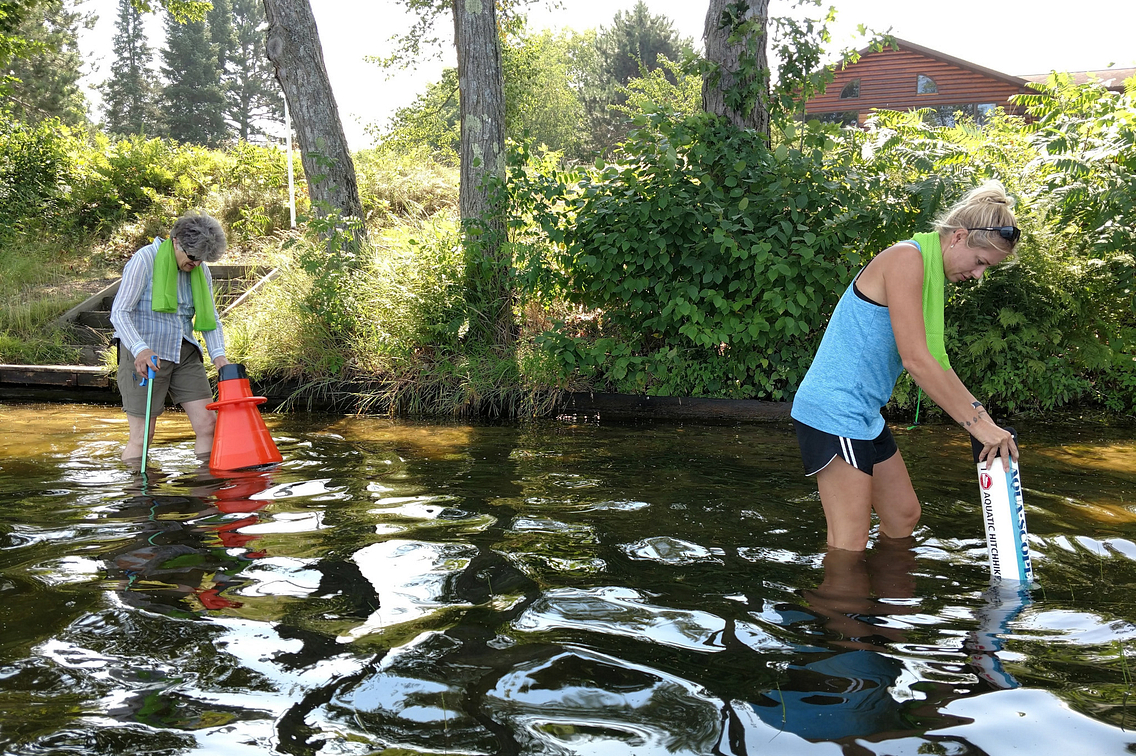 Efforts by DNR and partners to survey mussel populations have shown increases in some major rivers.© DNR FILES
Efforts by DNR and partners to survey mussel populations have shown increases in some major rivers.© DNR FILESTo get a more complete picture, the DNR in 2015 launched the first statewide survey for native mussels in 40 years. Conservation biologists reviewed historical mussel surveys between 1928 and 2015 and mapped all 615,000 records to zero in on locations to check for mussels.
Weinzinger, Kitchel and other DNR colleagues visited 99 sites to collect and record mussel information — identifying, aging and measuring them before returning them to the water. They found more than 21,000 living mussels representing 39 species.
Mussels' fortunes varied by species and waterbody. Populations and diversity were highest in the St. Croix River, with 24 species found at one site and high species diversity.
"There were times you'd be pulling up 200 to 300 mussels and 12 or so species in our 15-minute timed surveys," Weinzinger says of the St. Croix.
The Manitowish, Chippewa and Peshtigo rivers also showed strong mussel results, while other sites had declining populations and 10 sites had no mussels. The Pecatonica River, where DNR surveys 15 years earlier found four species listed as either threatened or endangered, now held none of them.
"The survey has been very important in helping us gather information on the distribution, population demographics and habitats of native mussels, all important information to help us focus our monitoring and other conservation efforts," Weinzinger says.
Mussel building at the Clam Palace
The biggest threats to native mussels are no longer pollution from the end of a factory or wastewater treatment pipe, but from so-called nonpoint sources, Kitchel says. Rain and melting snow run over agricultural lands and urban areas, pick up pollutants and carry them into streams and lakes.
Zebra mussels have receded as threats in some waters as populations of these nonnative mussels have stabilized or declined. At one point, zebra mussels piled 8 to 10 inches high on top of native mussels, smothering them, in the Mississippi River's east channel at Prairie du Chien. Now, native mussels are returning to the site where there's room among all the dead zebra mussel shells.
Once thought to be native mussels' Waterloo, zebra mussels spawned an ambitious effort starting in the early 2000s to rebuild populations of rare native mussels. Concern that operations and maintenance of the Upper Mississippi River locks were spreading zebra mussels spurred the U.S. Army Corps of Engineers and other partners to experiment growing their own endangered Higgins' eye mussels to "plant" in waters where zebra mussels weren't a problem, Kitchel says.
The partners built the "Clam Palace" at the U.S. Fish and Wildlife Service fish hatchery in Genoa, capitalizing on the abundance of a necessary ingredient: fish hosts.
After some experimentation, the staff collected Higgins' eye and put the glochidia in tanks with bass and walleye. They loaded the mussel-bound fish in stocking trucks and released them at two sites on the Lower Wisconsin Riverway. They also planted 2- to 3-year-old Higgins' eye reared in captivity at those sites and others in Illinois and Iowa.
The Clam Palace has been making new mussels ever since. In 2017, federal and state partners distributed endangered Higgins' eye, winged mapleleaf and salamander mussels in the Lower Chippewa River. DNR studies were underway this summer on the Lower Wolf River to identify suitable habitat for reintroducing endangered snuffbox mussels.
"It's worked really well for the majority of the species," Kitchel says.
Follow-up surveys indicate the propagated mussels have survived. In June, Kitchel received a sign they had been waiting for: A consultant familiar with mussels sent Kitchel a photo he had taken while camping along the Lower Wisconsin River.
"His wife found this mussel and asked him, 'What is this?' and he said, 'It's a baby Higgins' eye.' The significance is that it's likely a mussel from the Higgins' eye we planted in the river," Kitchel says. "So it's documentation of natural reproduction.
"That's a great sign and it's what we're hoping for at these other sites, too."
* * *
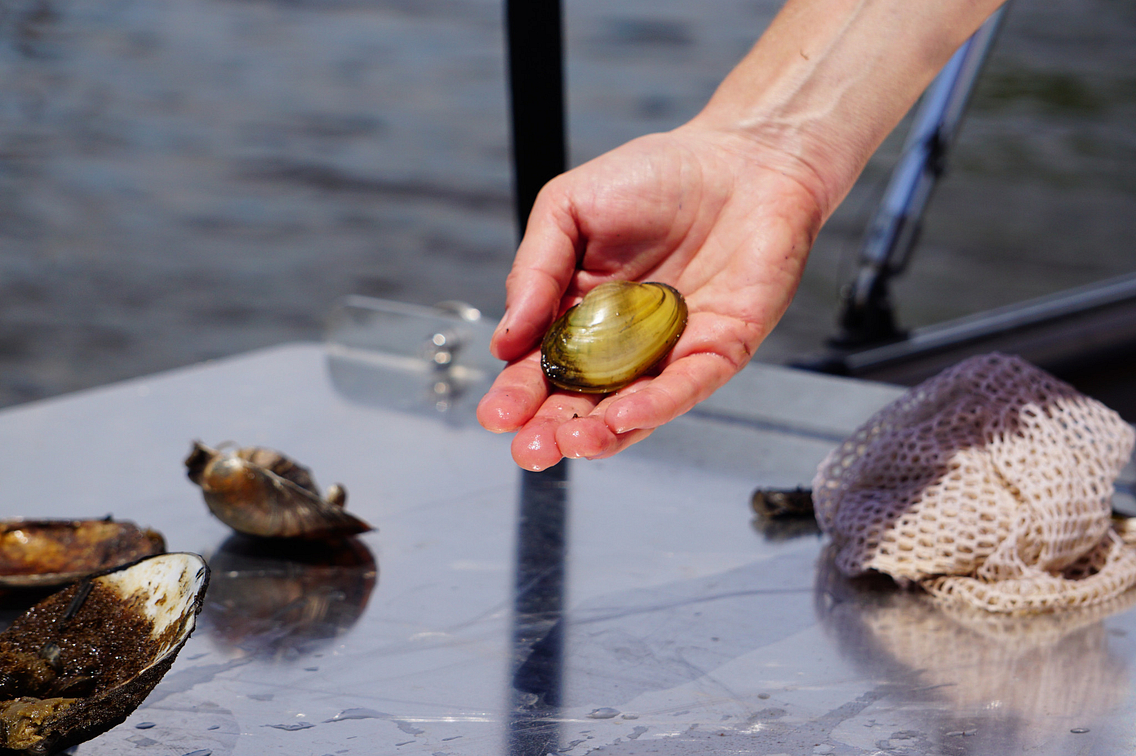 A fatmucket from Lower Green Bay where a recent mussel survey showed promising signs.© JACK SILVERBERG
A fatmucket from Lower Green Bay where a recent mussel survey showed promising signs.© JACK SILVERBERGMost of the mussels on today's four-dive set in Green Bay yield more dead shells than live mussels. But the live mussels include the rare mapleleaf and threeridges species as well as more common giant floaters, fragile papershells and lilliputs.
On the last dive, Winkler's findings feature a 2-year-old live fragile papershell while Weinzinger hauls in six live lilliputs ranging from 2 to 12 years old.
"I'm pretty hopeful," Weinzinger says. "Forty years ago, there weren't many fish here. If your host fish isn't here, mussels aren't going to be here.
"But starting with the Clean Water Act in 1972, these waters have been cleaned up and there are walleye, bass and over 40 species of fish."
As the day on the water ends, Weinzinger sounds a buoyant note.
"Whoever would have thought the water quality would have improved to the point we could be reintroducing mussels?" he says. "It's amazing."
Lisa Gaumnitz is a natural resources educator and program and policy analyst for the DNR.
Volunteer mussel monitoring
Since 2009, volunteers trained through the DNR's Wisconsin Mussel Monitoring Program have collected data that can be used to gauge long-term health trends for native mussels and streams. Coordinators Jesse Weinzinger and Lisie Kitchel partner with groups across Wisconsin to host mussel-related training events tailored to local needs. Paddlers, anglers, waterfront property owners and others are encouraged to photograph and report the live and dead mussels they see, following the simple steps described in a video and manual on the program website. For information including a downloadable mussel guide booklet or to find an event, visit Wisconsin Mussel Monitoring Program.

